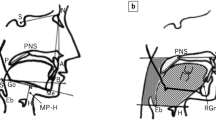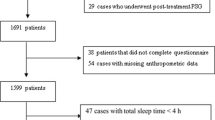Abstract
Purpose
The aims of the present study are to determine whether there is an obstructive sleep apnea (OSA) subgroup presenting with sawtooth sign on the spirometric flow-volume curve, and to identify the clinical importance of the sawtooth sign in these patients.
Methods
The study subjects consisted of 134 OSA patients (≥18 years) whose spirometric tests were made on the same day with the polysomnography. Patients without sawtooth sign were taken as the control group. Patients with sawtooth sign and control subjects were retrospectively analyzed in terms of distinctive demographic, anthropometric, polysomnographic, and spirometric characteristics.
Results
OSA patients with sawtooth sign (n = 36) had greater neck circumference and body weight, and were taller than control subjects (n = 98). Patients with sawtooth sign were mainly males (p < 0.01). Female/male ratios were similar in control subjects. The presence of coronary artery disease was higher (p = 0.024), and current smokers were more (p = 0.014) among the patients with sawtooth sign than control subjects. In logistic regression analysis, the presence of sawtooth sign and age were the only statistically significant parameters (p = 0.028 and p = 0.002, respectively) that affect the likelihood of coronary artery diseases. There were no differences among the groups with regard to age, BMI, wrist circumference, and other comorbid conditions. The duration time of oxygen desaturation (<90%), avarage, and longest duration of total apnea were longer (p = 0.050, p = 0.034 and p = 0.014, respectively) and the obstructive apnea index was more (p = 0.035) in OSA patients with sawtooth sign when compared to control subjects. There were no differences with regard to other polysomnographic parameters, sleep architecture, Epworth sleepiness score, and spirometric parameters.
Conclusions
As an OSA subgroup, the OSA patients with sawtooth sign may have more frequent and longer duration of obstructive apneas, longer duration time of oxygen desaturation, and greater risk for the coronary artery disease.

Similar content being viewed by others
Abbreviations
- OSA:
-
Obstructive sleep apnea
- BMI:
-
Body mass index
- ESS:
-
Epworth sleepiness score
References
Can M, Açikgöz S, Mungan G, Bayraktaroğlu T, Koçak E, Güven B, Demirtas S (2006) Serum cardiovascular risk factors in obstructive sleep apnea. Chest 129:233–237
Liistro G, Veriter C, Dury M, Aubert G, Stanescu D (1999) Expiratory flow limitation in awake sleep-disordered breathing subjects. Eur Respir J 14:185–190
Sabato R, Guido P, Salerno FG, Resta O, Spanevello A, Barbaro MP (2006) Airway inflammation in patients affected by obstructive sleep apnea. Monaldi Arch Chest Dis 65:102–105
Pillar G, Shehadeh N (2008) Abdominal fat and sleep apnea: the chicken or the egg? Diab Care 31(Suppl 2):S303–S309
Sanders MH, Martin RJ, Pennock BE, Rogers RM (1981) The detection of sleep apnea in the awake patient. the 'saw-tooth' sign. JAMA 245:2414–2418
Krieger J, Weitzenblum E, Vandevenne A, Stierle JL, Kurtz D (1985) Flow-volume curve abnormalities and obstructive sleep apnea syndrome. Chest 87:163–167
Zerah-Lancner F, Lofaso F, Coste A, Ricolfi F, Goldenberg F, Harf A (1997) Pulmonary function in obese snorers with or without sleep apnea syndrome. Am J Respir Crit Care Med 156:522–527
Katz I, Zamel N, Slutsky AS, Rebuck AS, Hoffstein V (1990) An evaluation of flow-volume curves as a screening test for obstructive sleep apnea. Chest 98:337–340
Rauscher H, Popp W, Zwick H (1990) Flow-volume curves in obstructive sleep apnea and snoring. Lung 168:209–214
Olson EJ, Simon PM (1996) Sleep-wake cycles and the management of respiratory failure. Curr Opin Pulm Med 2:500–506
Ashraf M, Shaffi SA, BaHammam AS (2008) Spirometry and flow-volume curve in patients with obstructive sleep apnea. Saudi Med J 29:198–202
Neukirch F, Weitzenblum E, Liard R, Korobaeff M, Henry C, Orvoën-Frija E, Kauffmann F (1992) Frequency and correlates of the saw-tooth pattern of flow-volume curves in an epidemiological survey. Chest 101:425–431
Haponik EF, Smith PL, Kaplan J, Bleecker ER (1983) Flow-volume curves and sleep-disordered breathing: therapeutic implications. Thorax 38:609–615
American Thoracic Society (1995) Standardization of spirometry, 1994 update. Am J Respir Crit Care Med 152:1107–1136
Rechtschaffen A, Kales A (1968) A manual of standardized terminology, techniques and scoring system for sleep stages in human subjects. Brain Information Service: Los Angeles, UCLA
Iber C, Ancoli-Israel S, Chesson A, Quan SF for the American Academy of Sleep Medicine (2007) The AASM manual for the scoring of sleep and associated events: rules, terminology and technical specifications,1st edn. Westchester, Illinois
Modrykamien AM, Gudavalli R, McCarthy K, Liu X, Stoller JK (2009) Detection of upper airway obstruction with spirometry results and the flow-volume loop: a comparison of quantitative and visual inspection criteria. Respir Care 54:474–479
Shore ET, Millman RP (1984) Abnormalities in the flow-volume loop in obstructive sleep apnoea sitting and supine. Thorax 39:775–779
Oztürk L, Metin G, Cuhadaroğlu C, Utkusavaş A, Tutluoğlu B (2005) FEF(25-75)/FVC measurements and extrathoracic airway obstruction in obstructive sleep apnea patients. Sleep Breath 9:33–38
Peker Y, Hedner J, Norum J, Kraiczi H, Carlson J (2002) Increased incidence of cardiovascular disease in middle-aged men with obstructive sleep apnea: a 7-year follow-up. Am J Respir Crit Care Med 166:159–165
Kiely JL, McNicholas WT (2000) Cardiovascular risk factors in patients with obstructive sleep apnoea syndrome. Eur Respir J 16:128–133
Peker Y, Kraiczi H, Hedner J, Löth S, Johansson A, Bende M (1999) An independent association between obstructive sleep apnoea and coronary artery disease. Eur Respir J 14:179–184
Peker Y, Hedner J, Kraiczi H, Löth S (2000) Respiratory disturbance index: an independent predictor of mortality in coronary artery disease. Am J Respir Crit Care Med 162:81–86
Wetter DW, Young TB, Bidwell TR, Badr MS, Palta M (1994) Smoking as a risk factor for sleep-disordered breathing. Arch Intern Med 154:2219–2224
Olson EJ, Park JG, Morgenthaler TI (2005) Obstructive sleep apnea-hypopnea syndrome. Prim Care 32:329–359
Collop NA (2005) Obstructive sleep apnea syndromes. Semin Respir Crit Care Med 26:13–24
Shahar E, Whitney CW, Redline S, Lee ET, Newman AB, Javier Nieto F, O'Connor GT, Boland LL, Schwartz JE, Samet JM (2001) Sleep-disordered breathing and cardiovascular disease: cross-sectional results of the Sleep Heart Health Study. Am J Respir Crit Care Med 163:19–25
Leung RS, Bradley TD (2001) Sleep apnea and cardiovascular disease. Am J Respir Crit Care Med 164:2147–2165
Vincken WG, Cosio MG (1989) Flow oscillations on the flow-volume loop: clinical and physiological implications. Eur Respir J 2:543–549
Author information
Authors and Affiliations
Corresponding author
Rights and permissions
About this article
Cite this article
Levent, E., Sarıman, N. Analysis of obstructive sleep apnea patients with “sawtooth sign” on the flow-volume curve. Sleep Breath 15, 357–365 (2011). https://doi.org/10.1007/s11325-010-0393-9
Received:
Revised:
Accepted:
Published:
Issue Date:
DOI: https://doi.org/10.1007/s11325-010-0393-9




